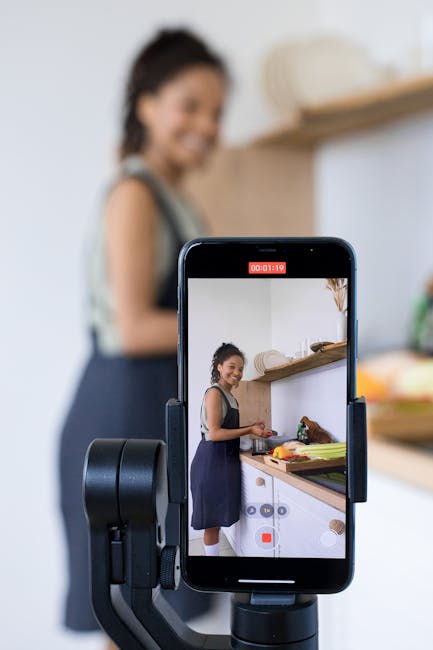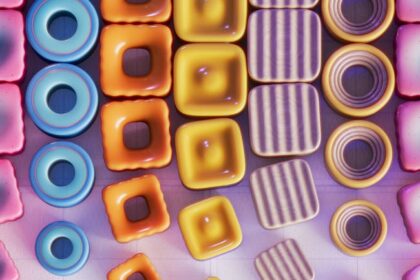Maximizing Engagement: YouTube Ad Creative Best Practices
Understanding the intricacies of YouTube ad creative is paramount for driving meaningful engagement and achieving campaign objectives. Beyond mere impressions, true engagement signifies a viewer’s active interaction with the ad content, whether through watching the full duration, clicking a call-to-action (CTA), or developing a positive brand association. This deep dive into creative best practices explores the multifaceted elements that coalesce to form highly effective YouTube advertisements, moving beyond superficial aesthetics to embrace strategic design, psychological triggers, and technical precision.
The Foundation of Engagement: Audience and Format Synergy
Effective YouTube ad creative begins with a profound understanding of the target audience and the specific ad format chosen. Each ad format on YouTube presents unique opportunities and constraints that directly influence creative development. Generic creative rarely yields optimal engagement; instead, tailored content resonating with a defined demographic’s interests, pain points, and viewing habits is essential. Researching audience demographics, psychographics, and online behaviors through tools like Google Analytics, YouTube Analytics, and market research reports provides the foundational data necessary to craft compelling narratives and visual experiences. What captivates a Gen Z audience on mobile might drastically differ from what appeals to baby boomers viewing on a smart TV.
YouTube’s diverse ad formats – including skippable in-stream, non-skippable in-stream, bumper ads, in-feed video ads (formerly TrueView discovery), Outstream, and Masthead ads – each demand distinct creative considerations. For skippable in-stream ads, the first five seconds are critically important, serving as the “hook” to prevent viewers from skipping. The creative must immediately establish value, intrigue, or a strong emotional connection. Non-skippable in-stream ads, limited to 15-20 seconds, necessitate a concise, high-impact message delivered with absolute clarity. Bumper ads, at a mere six seconds, are micro-stories requiring extreme brevity and a singular, memorable message, often leveraging strong branding or a quick emotional punch. In-feed video ads rely heavily on compelling thumbnails and headlines to entice clicks, akin to traditional content marketing. Outstream ads, appearing on partner websites and apps, must be designed for mobile-first, silent viewing, making on-screen text and captions indispensable. Masthead ads, occupying prime real estate on the YouTube homepage, demand broadcast-quality production and a powerful opening statement to leverage their immense reach. Aligning creative strategy with the inherent characteristics of each format is the first step toward maximizing engagement.
The Crucial Opening: The Art of the Immediate Hook
The initial seconds of any YouTube ad are arguably the most important, especially for skippable formats. This “hook” must be designed to halt the viewer’s scroll or prevent the dreaded “skip ad” button click. A strong hook isn’t just visually striking; it’s strategically crafted to instantly communicate relevance, spark curiosity, or present an irresistible value proposition. Techniques for an effective hook include:
- Problem-Agitation-Solution (PAS): Immediately present a relatable problem that resonates with the audience, briefly agitate the pain point, and then hint at the solution your product or service offers.
- Intriguing Question: Pose a direct question that challenges the viewer’s assumptions or taps into their desires, prompting them to seek the answer within the ad.
- Bold Statement or Statistic: Open with a shocking fact, a surprising claim, or a powerful declaration that demands attention and establishes immediate credibility or controversy.
- Visual Intrigue: Employ visually captivating elements – a unique animation, an unexpected scene, a high-energy montage, or a visually stunning product shot – that break through the visual clutter.
- Emotional Connection: Tap into universal emotions like humor, empathy, joy, or aspiration right from the start, creating an immediate bond with the viewer.
- Direct-to-Camera Address: A charismatic spokesperson directly addressing the viewer can create a sense of personal connection and urgency, drawing them into the conversation.
Regardless of the specific technique, the hook must be highly focused, devoid of extraneous information, and directly aligned with the core message and target audience. For longer skippable ads, the hook isn’t just about preventing the skip; it’s about establishing an implicit contract with the viewer: “Watch this, and you will gain something valuable.” This early value exchange is fundamental to sustained engagement. The first 5-10 seconds should encapsulate the essence of the ad, providing enough information to capture interest without giving away the entire narrative. This delicate balance ensures viewers remain curious and invested in discovering the full story or solution presented within the ad. For bumper ads, the entire 6 seconds is the hook, requiring maximum impact from the very first frame.
The Power of Narrative: Storytelling in Ad Creative
Beyond the initial hook, sustained engagement hinges on compelling storytelling. Even in short-form ads, a coherent narrative arc transforms a commercial message into an engaging experience. Humans are hardwired for stories; they make information more memorable, relatable, and emotionally impactful. Effective storytelling in YouTube ad creative often follows classic narrative structures:
- Hero’s Journey (or Customer’s Journey): The viewer (or a relatable character) faces a challenge, discovers your product/service as the solution, and achieves a positive transformation. This resonates deeply as it mirrors personal aspirations for improvement.
- Problem-Solution-Benefit: Elaborate on the problem introduced in the hook, demonstrate how your product/service uniquely solves it, and then showcase the tangible benefits and emotional satisfaction derived from using it.
- Before-and-After: Visually contrast a negative “before” state (without the product) with a positive “after” state (with the product), highlighting the transformative power.
- Brand Origin Story: Share the inspiration behind your brand or product, emphasizing values, passion, and authenticity. This builds trust and emotional connection.
- Testimonial/User Story: Feature real customers sharing their positive experiences, lending authenticity and social proof. Their journey becomes a relatable narrative.
Regardless of the chosen structure, the story should be concise, clear, and emotionally resonant. Every element – visuals, audio, pacing – should serve the narrative. Characters, even if they appear briefly, should be relatable and aspirational. The conflict (the problem) and resolution (the product/service) should be clearly defined. The goal is to make the viewer feel something – joy, relief, understanding, inspiration – because emotional engagement is far more powerful than purely cognitive processing. A well-told story transcends a mere sales pitch, making the brand or product an integral part of the viewer’s potential personal narrative. This is particularly effective for TrueView campaigns where viewers have the option to skip; a captivating story keeps them watching.
Visual Excellence: Crafting the On-Screen Experience
High-quality visuals are non-negotiable for maximizing YouTube ad engagement. In a platform saturated with professionally produced content, ads must meet or exceed viewer expectations for aesthetic appeal and technical execution.
- High Production Value: This encompasses sharp resolution (minimum 1080p, ideally 4K), excellent lighting, professional cinematography, and stable camera work. Poor visual quality signals a lack of professionalism and can immediately disengage viewers.
- Compelling Composition: Utilize principles of photography and videography, such as the rule of thirds, leading lines, and balanced framing, to create visually pleasing and dynamic shots that guide the viewer’s eye.
- Color Psychology & Branding: Strategic use of color can evoke emotions and strengthen brand recognition. Integrate brand colors consistently but subtly throughout the ad. A cohesive color palette contributes to a polished, professional look.
- On-Screen Text and Graphics: Use text sparingly but effectively to highlight key messages, statistics, or CTAs. Ensure text is legible on all devices, especially mobile, with appropriate font choices and contrast. Motion graphics and animations can add dynamism and explain complex concepts succinctly.
- Product Showcase & Demonstration: When featuring a product, showcase it clearly and aesthetically. Demonstrations should be practical, clear, and highlight key features and benefits in action. Avoid clutter and ensure the product is always presented in its best light.
- Diversity and Inclusivity: Represent a diverse range of people, cultures, and experiences in your visuals. This broadens appeal, fosters relatability, and demonstrates social consciousness, resonating with a wider audience base.
- Authenticity vs. Polish: While high production value is key, some campaigns benefit from a more authentic, less polished aesthetic, particularly for UGC-style ads or testimonials. The key is intentionality: choose the visual style that best serves the message and target audience. For instance, an ad featuring user-generated content might intentionally be less polished to convey genuine experiences, while a luxury brand ad would demand exquisite cinematography.
- Scene Variety and Visual Flow: Avoid static shots or repetitive imagery. Vary shot types (wide, medium, close-up, B-roll) and camera angles to maintain visual interest. Ensure smooth transitions between scenes that contribute to the narrative flow rather than jarring the viewer.
Audio Excellence: The Unsung Hero of Engagement
Often underestimated, audio quality plays a pivotal role in YouTube ad engagement. Poor audio – muffled dialogue, distracting background noise, uneven levels – is a primary reason viewers disengage, even more so than mediocre visuals for some.
- Crystal-Clear Dialogue: All spoken words, whether from a spokesperson, actor, or voiceover artist, must be perfectly clear and intelligible. Invest in professional microphones and proper sound recording techniques.
- Professional Voiceovers: If using voiceovers, choose a voice artist whose tone, pacing, and accent align with your brand identity and target audience. The delivery should be engaging and articulate.
- Strategic Use of Music: Background music sets the mood, reinforces emotions, and enhances the narrative. Select music that complements the ad’s message and tone, avoiding generic or distracting tracks. Ensure the music volume is balanced so it doesn’t overpower dialogue. Music can also be used to build tension, create excitement, or evoke nostalgia.
- Impactful Sound Effects: Sound effects can emphasize actions, highlight product features, or add a layer of realism and immersion. Use them judiciously to enhance the visual story without becoming overwhelming.
- Consistent Audio Levels: Ensure consistent volume levels throughout the ad, preventing sudden jumps or drops that force viewers to adjust their volume. A professional audio mix is crucial.
- Sound Design for Emotion: Beyond mere clarity, thoughtful sound design can profoundly impact emotional engagement. The subtle hum of a new appliance, the satisfying click of a product, or ambient background sounds can immerse the viewer more deeply.
- Accessibility through Audio: Consider audio descriptions for visually impaired audiences, enhancing inclusivity and broadening reach.
For ads designed for silent viewing (like Outstream or many social media feeds), the audio considerations shift. While quality remains important for those who do unmute, the visual narrative and on-screen text must carry the primary message effectively without relying on sound. However, the potential for viewers to unmute means that good audio is still a valuable asset.
Pacing and Editing: Maintaining Viewer Momentum
The pacing and editing of a YouTube ad are critical for sustaining engagement and ensuring the message is delivered effectively within the allocated time.
- Dynamic Pacing for Early Engagement: The initial seconds should be fast-paced and dynamic to quickly capture attention. Quick cuts, rapid scene changes, and immediate action can hook viewers before they have a chance to skip.
- Varying Pacing for Narrative Arc: While the beginning might be rapid, the pacing can vary throughout the ad to match the narrative. Slower moments might be used for emotional connection or detailed explanations, while faster segments can build excitement or convey urgency.
- Conciseness and Efficiency: Every second counts. Eliminate dead air, unnecessary shots, or redundant information. Get straight to the point and deliver the message efficiently. This doesn’t mean sacrificing detail, but rather presenting information in its most distilled, impactful form.
- Smooth Transitions: Seamless transitions between scenes maintain a professional feel and ensure a smooth viewing experience. Avoid jarring cuts or amateurish effects that distract from the message.
- Matching Pacing to Message: A humorous ad might benefit from quick, comedic timing, while a serious or emotional ad might require slower, more deliberate pacing to allow moments to sink in. Align the rhythm of the editing with the core message and desired emotional response.
- Optimizing for Length: Tailor editing to the ad format’s length constraints. A 6-second bumper ad will have extremely rapid cuts and a singular focus, whereas a 30-second skippable ad allows for more developed scenes and a slightly more nuanced narrative, and a longer form content ad will need to carefully build its argument.
- Relevance Every Second: Ensure that every frame, every cut, and every audio cue contributes to the overall message and engagement goal. If a segment doesn’t add value, it should be removed. This ruthless efficiency is key to keeping viewers engaged until the CTA.
Branding Integration: Seamless Recognition
Effective ad creative doesn’t just sell a product; it reinforces the brand. Seamless and consistent branding is vital for long-term recognition and recall.
- Early and Consistent Brand Presence: Introduce your brand logo or name subtly within the first few seconds of the ad. This ensures that even if viewers skip, they’ve had a brief exposure to your brand. Don’t make it intrusive; integrate it naturally, perhaps as a watermark, on product packaging, or within the set design.
- Visual Identity Consistency: Use consistent brand colors, typography, imagery style, and overall aesthetic that align with your brand guidelines across all creative assets. This creates a cohesive and recognizable brand experience.
- Audio Branding: Incorporate brand jingles, specific sound effects, or a consistent voiceover tone that viewers associate with your brand.
- Product Placement: If your product is a physical item, ensure it’s prominently yet naturally displayed. Showcase it in action, highlighting its design and benefits.
- Narrative Integration: Weave your brand’s values, mission, or unique selling proposition (USP) into the ad’s narrative. The story should inherently reflect what your brand stands for.
- Clear End Screen: The final seconds of the ad should clearly feature your brand logo, name, and a compelling call-to-action. This is the last opportunity to solidify brand recall and direct viewer action.
- Brand Personality: Let your brand’s personality shine through the creative. Whether it’s humorous, serious, innovative, or heartwarming, maintain a consistent tone that defines your brand.
Call to Action (CTA) Optimization: Guiding the Next Step
An ad’s ultimate goal is to drive action, and a well-optimized call to action (CTA) is the bridge between engagement and conversion.
- Clarity and Simplicity: The CTA must be unambiguous. Viewers should know exactly what you want them to do (e.g., “Shop Now,” “Learn More,” “Subscribe,” “Download App”). Avoid jargon or multiple confusing options.
- Compelling Value Proposition: The CTA should be accompanied by a clear reason to act. Why should they click? What benefit will they receive? (e.g., “Shop Now for 20% off,” “Learn More about [Benefit]”).
- Strategic Placement:
- Early (Soft) CTAs: For longer skippable ads, consider a soft CTA or a persistent clickable element (like a companion banner) early on for viewers who are ready to convert quickly.
- Mid-Ad Reinforcement: For narrative ads, subtly reinforce the CTA or value proposition around the mid-point to keep it top-of-mind.
- End-Screen Dominance: The most prominent and compelling CTA should appear at the end of the ad, typically on a dedicated end screen or integrated into the final seconds. This is where viewers are most primed to act after consuming the message.
- Visual Prominence: Make the CTA button or text visually distinct and easy to spot. Use contrasting colors, clear typography, and sufficient sizing.
- Verbal CTA Reinforcement: If your ad includes dialogue or voiceover, explicitly state the CTA verbally in conjunction with the on-screen text. Auditory reinforcement enhances memorability and comprehension.
- Sense of Urgency/Scarcity: Where appropriate, create a sense of urgency (e.g., “Limited Time Offer,” “While Supplies Last”) to encourage immediate action.
- Single-Minded Focus: While multiple clickable elements can exist (e.g., website link, social media links), the primary CTA should be the single, most important action you want the viewer to take. Avoid overwhelming choices.
- Testing CTA Variations: A/B test different CTA phrases, button colors, placements, and supporting copy to determine which performs best for your specific audience and objective.
- Mobile-First Design: Ensure CTA buttons are large enough and easily tappable on mobile devices, where finger accuracy can be an issue.
Mobile Optimization: The Dominant Viewing Experience
A significant portion of YouTube viewing occurs on mobile devices. Designing ad creative with a mobile-first mindset is no longer optional; it’s essential for maximizing engagement.
- Vertical Video Considerations: While horizontal (16:9) remains standard, experiment with vertical (9:16) video formats, especially for Shorts or mobile-specific campaigns, as they naturally fill the screen on smartphones and offer an immersive viewing experience without requiring device rotation.
- Thumb-Stopping Power: On mobile, users scroll quickly. Your initial frames and thumbnails (for in-feed ads) must be immediately arresting and clear, even on a small screen. Bold visuals, clear text, and immediate action are key.
- Readability of On-Screen Text: Text overlays and graphics must be large enough and have sufficient contrast to be legible on small mobile screens. Avoid dense blocks of text.
- Silent Viewing by Default: Many mobile users watch videos with sound off. This makes captions, on-screen text, and strong visual storytelling absolutely critical. The ad should be fully understandable without audio.
- Clutter-Free Visuals: Keep compositions clean and focused. Too many elements can make the screen appear cluttered and overwhelming on a small device.
- Fast Load Times: Ensure video assets are optimized for fast loading on mobile networks, as slow loading can lead to abandonment.
- Interactive Elements: Ensure any interactive elements or clickable CTAs are large enough and responsive on touchscreens.
Accessibility: Broadening Reach and Inclusivity
Designing for accessibility isn’t just a compliance issue; it’s a strategic move that expands your potential audience and enhances engagement for everyone.
- Closed Captions and Subtitles: Provide accurate and synchronized closed captions or subtitles for all spoken dialogue. This is crucial for viewers who are hearing-impaired, watching in sound-off environments, or viewing in a language different from their native tongue. Machine-generated captions are a starting point, but human-reviewed captions are always superior for accuracy.
- Audio Descriptions: For visually impaired audiences, consider providing an audio description track that narrates key visual elements, actions, and on-screen text.
- Inclusive Visuals: Ensure your ad creative visually represents people from diverse backgrounds, abilities, and identities. This fosters relatability and broadens the ad’s appeal to a wider audience.
- Clear and Simple Language: Use straightforward language that is easy to understand, avoiding overly complex jargon or obscure references that might exclude some viewers.
- Color Contrast: Ensure sufficient color contrast for on-screen text and graphics, making them readable for viewers with color blindness or visual impairments.
Leveraging User-Generated Content (UGC): Authenticity and Trust
Incorporating user-generated content (UGC) into YouTube ad creatives can significantly boost engagement by leveraging authenticity and social proof.
- Authenticity over Perfection: UGC often feels more genuine and relatable than highly polished studio productions. This authenticity can build trust with viewers, as it appears to be a real, unbiased endorsement.
- Social Proof: Seeing real people use and love a product acts as powerful social proof, influencing potential customers to trust the brand.
- Diverse Perspectives: UGC can showcase a product being used in various real-life scenarios by diverse individuals, offering different perspectives and broadening appeal.
- Cost-Effective Production: While not always the primary driver, UGC can sometimes be a more cost-effective creative asset, allowing for more frequent creative refreshes.
- Types of UGC:
- Testimonials: Direct customer reviews and positive experiences.
- Unboxing Videos: Showing the excitement of receiving and opening a product.
- How-to/Demonstration: Users showing practical applications of the product.
- “My Story” Videos: Personal narratives of how a product solved a problem or improved a life.
- Integration Best Practices:
- Curate Carefully: Select high-quality, relevant, and brand-aligned UGC.
- Obtain Permissions: Always secure proper rights and permissions from users before using their content in ads.
- Add Production Polish (Subtly): While maintaining authenticity, basic editing, consistent branding, and clear audio can elevate UGC without making it feel overly produced.
- Combine with Professional Content: UGC can be used effectively in combination with professionally shot footage, perhaps as testimonials interspersed within a broader brand narrative.
A/B Testing and Iteration: The Engine of Creative Optimization
Creative development is not a one-time event; it’s an ongoing process of testing, learning, and refining. A/B testing different creative elements is crucial for understanding what truly resonates with your audience and drives the highest engagement.
- Isolate Variables: Test one key creative element at a time to accurately determine its impact. This could include:
- Hooks: Different opening 5-10 seconds.
- CTAs: Different phrasing, button colors, or placement.
- Video Lengths: Comparing a 15-second vs. 30-second version.
- Visual Styles: Comparing polished vs. authentic, or different visual approaches.
- Audio Tracks: Different background music or voiceover styles.
- Spokesperson/Character: Different talent or on-screen personalities.
- Narrative Arcs: Problem-solution vs. aspirational storytelling.
- Defined Metrics: Clearly define the engagement metrics you’re optimizing for (e.g., view-through rate, click-through rate, conversion rate, audience retention rate, brand lift).
- Statistical Significance: Ensure your tests run long enough and gather enough data to achieve statistical significance, providing reliable insights.
- Audience Segmentation: Test creative variations across different audience segments, as what works for one demographic might not work for another.
- Data-Driven Decisions: Use the insights from A/B tests to inform future creative iterations. This iterative process of “test, learn, apply” is the most effective path to continuous improvement in ad performance.
- Don’t Be Afraid to Fail: Not every test will yield a clear winner, and sometimes the hypothesis will be proven wrong. These “failures” are valuable learning opportunities that prevent wasted ad spend on underperforming creative.
- Refresh Creative Regularly: Audiences experience “ad fatigue” over time, where the effectiveness of a creative asset diminishes due to repeated exposure. Regular creative refreshes, informed by A/B testing, are essential to maintain engagement and prevent diminishing returns.
Advanced Strategies for Elevated Engagement
Moving beyond the fundamentals, several advanced strategies can push YouTube ad creative engagement to new heights.
- Personalization and Dynamic Creative Optimization (DCO): Leverage data to personalize ad content for individual viewers. DCO platforms can dynamically assemble ad variations based on viewer demographics, interests, past behaviors, or real-time context. For example, showing a local store address, or a product they recently viewed on your website. This hyper-relevance significantly boosts engagement.
- Interactive Ad Formats: Explore interactive elements within ads, such as polls, quizzes, or playable ads. These formats turn passive viewing into active participation, increasing time spent and direct interaction with the brand. YouTube’s card and end screen elements can add basic interactivity, but more advanced options exist through partners.
- Remarketing with Tailored Creative: Create specific ad creatives for remarketing audiences. These ads can reference their prior interaction (e.g., “Still thinking about that product?”), offer a special incentive, or provide more detailed information, leveraging existing interest for higher engagement.
- Sequential Storytelling: For complex products or services, use a series of ads to tell a longer story in sequence, building anticipation and providing information incrementally. This approach can be highly engaging as viewers follow the narrative journey.
- Leveraging YouTube Shorts: Adapt creative for the vertical, fast-paced, and music-driven format of YouTube Shorts. These ads demand extreme brevity, strong visual hooks, and often incorporate trending sounds or challenges.
- Embracing Authenticity and Imperfection: In an era of polished perfection, sometimes raw, authentic, and even slightly imperfect content can resonate more deeply. This often ties into UGC but can also apply to brand-created content that feels less “ad-like” and more organic.
- Community Engagement Integration: Encourage viewers to comment, share, or visit your channel for more content within the ad itself. This fosters a sense of community around your brand.
- Experiment with AI-Powered Creative Tools: Artificial intelligence is increasingly being used to analyze vast amounts of data to predict which creative elements will perform best, generate ad copy, or even assist in video editing, leading to more optimized creative faster.
- Sound Design for “Silent First” Experience: While already mentioned for mobile, expand this concept: design the visual narrative and on-screen text to be compelling and understandable even without audio for all viewing environments, as many users browse without sound on by default. Ensure that if sound is turned on, it only enhances the experience, it doesn’t become essential for understanding.
- Leveraging Influencer Collaborations: Partnering with relevant YouTube influencers can significantly boost engagement. Their authentic endorsement and ability to connect with their audience transfer trust and interest to your ad creative. The creative should feel native to the influencer’s content style.
- Humor and Relatability: When appropriate for the brand, injecting humor or creating highly relatable scenarios can make ads highly memorable and shareable, leading to organic engagement beyond paid views.
- Addressing Pain Points Directly and Empathetically: Rather than just selling features, create ads that show a deep understanding of the audience’s pain points and offer solutions with genuine empathy. This builds a stronger emotional connection.
- Live-Action vs. Animation vs. Mixed Media: Experiment with different creative styles. Live-action can convey authenticity, animation allows for abstract concepts and strong visual branding, while mixed media can create unique, engaging visual experiences. The choice should align with the message and audience.
- Cultural Relevance and Localization: Ensure creative is culturally appropriate and localized for different geographic markets. This includes not just language translation but also adapting visuals, references, and humor to resonate with local customs and sensibilities.
- Leveraging Trends and Memes (Carefully): While risky, incorporating relevant and timely internet trends or memes can make an ad feel current and shareable, but it must be done authentically and quickly to avoid appearing forced or outdated.
The Role of Context and Placement in Engagement
While creative is king, its effectiveness is amplified by appropriate context and placement. An amazing ad placed before an irrelevant video, or seen by an uninterested audience, will fall flat.
- Audience Targeting Alignment: Ensure your creative message is precisely tailored to the audience segments you are targeting. A highly personalized message resonates more deeply.
- Content Alignment: Where possible, leverage content targeting to show your ads alongside YouTube videos or channels that are thematically relevant to your product or service. This contextual relevance increases the likelihood of engagement.
- Placement Strategy: Understand the nuances of different placements (in-stream, in-feed, masthead, outstream). For instance, an engaging, longer narrative might thrive as a skippable in-stream ad, while a quick brand message is better suited for a bumper.
- Competitive Analysis: Analyze what your competitors are doing well (or poorly) in their YouTube ad creative. This can provide insights into industry best practices and opportunities for differentiation.
- Seasonal and Event-Based Creative: Develop specific creative for holidays, seasonal trends, or major events. Timeliness can significantly boost relevance and engagement.
- Attribution Modeling: Understand how your YouTube ad creative contributes to the broader customer journey. Engagement metrics are important, but ultimately, they should lead to tangible business outcomes, measured through comprehensive attribution models.
Measuring and Analyzing Engagement Beyond Views
To truly maximize engagement, one must understand how to measure it effectively, moving beyond vanity metrics to actionable insights.
- View-Through Rate (VTR): For skippable ads, this measures the percentage of people who watch the entire ad (or 30 seconds, whichever is shorter). A high VTR indicates a strong hook and compelling creative throughout.
- Audience Retention: YouTube Analytics provides graphs showing at what points viewers drop off. Analyzing these graphs helps identify specific moments in the creative that are causing disengagement, allowing for targeted optimization. A sharp drop-off early on suggests issues with the hook; later drops point to pacing or message fatigue.
- Click-Through Rate (CTR): This measures how many viewers click on your CTA. A high CTR indicates that the CTA is clear, compelling, and that the ad successfully motivated action.
- Conversion Rate: Beyond clicks, how many viewers actually complete a desired action (e.g., purchase, sign-up, download) after clicking? This is the ultimate measure of creative effectiveness in driving business outcomes.
- Brand Lift Studies: For brand awareness and perception goals, YouTube’s Brand Lift surveys (available through Google Ads) measure the impact of your ads on metrics like brand awareness, ad recall, consideration, favorability, and purchase intent. This provides qualitative insights into how your creative is influencing brand perception.
- Engagement Rate (Likes, Comments, Shares): While not direct ad performance metrics, monitoring comments, shares, and likes on ads (especially those published to your channel) can provide qualitative feedback on viewer sentiment and indicate high organic engagement. Positive comments and shares are powerful indicators of creative resonance.
- Cost Per Engagement (CPE): For TrueView campaigns, this measures the cost you pay for an engaged view (a view of 30 seconds or more, or a click, whichever comes first). A lower CPE indicates more efficient creative.
- Sentiment Analysis: Tools can analyze comments on your ads or mentions of your brand post-ad exposure to gauge overall sentiment (positive, negative, neutral) towards your creative and brand.
- Heatmaps and Eyetracking (Experimental): While more advanced, some agencies use heatmaps or eye-tracking studies on mock-ups or early versions of creative to understand where viewers’ attention is drawn, informing visual design choices.
By meticulously tracking these metrics and using them as a feedback loop for creative development, marketers can continuously refine their YouTube ad creative to achieve maximum engagement and deliver superior return on investment. The pursuit of engagement is a continuous journey, driven by data, creativity, and a deep understanding of the human element behind the screen.











